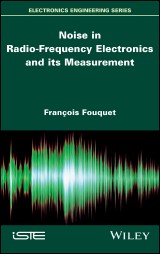Details

Noise in Radio-Frequency Electronics and its Measurement
Wiley-ISTE Series 1. Aufl.
|
139,99 € |
|
| Verlag: | Wiley |
| Format: | |
| Veröffentl.: | 26.02.2020 |
| ISBN/EAN: | 9781119706694 |
| Sprache: | englisch |
| Anzahl Seiten: | 188 |
DRM-geschütztes eBook, Sie benötigen z.B. Adobe Digital Editions und eine Adobe ID zum Lesen.
Beschreibungen
<P>The ability of wireless communication devices to transmit reliable information is fundamentally limited by sources of noise related to the electronic components in use. <P>Noise in Radio-Frequency Electronics and its Measurement has five chapters that address the theoretical aspects of this subject, and concludes with a series of exercises and solutions. The book examines the origin and sources of noise inside electronic radio-frequency circuits, their impact in telecommunications, their modeling and their measurement. Particular attention is dedicated to the origins, establishment and significance of formulas that are used when the noise characteristics of an electronic circuit are modeled or measured. <P>This book instructs the reader in the application of the examined methods and their adaptation to solving problems, as well as how to comfortably use the presented formulas.
<p>Preface ix</p> <p>List of Symbols xi</p> <p>Introduction xv</p> <p><b>Chapter 1. Background Noise in Electronics </b><b>1</b></p> <p>1.1. Introduction 1</p> <p>1.2. Spontaneous fluctuations in electronic components 2</p> <p>1.2.1. Introduction 2</p> <p>1.2.2. Thermal noise 2</p> <p>1.2.3. Shot noise 7</p> <p>1.2.4. Generation / recombination noise 7</p> <p>1.2.5. Excess noise 8</p> <p>1.3. Noise factor 9</p> <p>1.3.1. Definition 9</p> <p>1.3.2. Reference temperature for the noise factor 11</p> <p>1.3.3. Importance of the noise factor in telecommunications 12</p> <p>1.4. Noise in two-ports 13</p> <p>1.4.1. Representation of noise in two-ports 13</p> <p>1.4.2. Expression of the noise factor of a two-port 15</p> <p>1.4.3. Minimum noise factor of a two-port 16</p> <p>1.4.4. Inverse relations 19</p> <p>1.5. Characterization of noise in a two-port 20</p> <p>1.6. Conclusion 22</p> <p><b>Chapter 2. Friis Formula 23</b></p> <p>2.1. Introduction 23</p> <p>2.2. Calculation method 24</p> <p>2.3. Calculation of the admittance parameters of the Q1, Q2 association in cascade 26</p> <p>2.4. Contribution of noise generators <i>e<sub>1</sub></i>, <i>i<sub>1</sub></i>, <i>e<sub>2</sub> </i>and <i>i<sub>2</sub> </i>to <i>I<sub>1</sub> </i>and <i>I<sub>4</sub> </i>27</p> <p>2.4.1. Introduction 27</p> <p>2.4.2. Contribution of the noise generator <i>e<sub>1 </sub></i>27</p> <p>2.4.3. Contribution of the noise generator <i>i<sub>1</sub> </i>28</p> <p>2.4.4. Contribution of the noise generator <i>e<sub>2</sub> </i>28</p> <p>2.4.5. Contribution of the noise generator <i>i<sub>2</sub> </i>29</p> <p>2.5. <i>e<sub>Tot</sub> </i>and <i>i<sub>Tot</sub> </i>identification 30</p> <p>2.6. Calculation of F<sub>12</sub>(YS) 30</p> <p>2.7. Friis Formula 31</p> <p>2.7.1. Introduction 31</p> <p>2.7.2. Transducer power gain 32</p> <p>2.7.3. Available power gain 34</p> <p>2.8. Conclusion 35</p> <p><b>Chapter 3. Adapted Attenuator and Noise Factor </b><b>37</b></p> <p>3.1. Introduction 37</p> <p>3.2. Calculation of Y and S parameters 38</p> <p>3.3. General representation of noise in two-ports 39</p> <p>3.4. Equivalent noise generators at the input of the adapted attenuator 40</p> <p>3.5. Noise factor on 50 Ω of the adapted attenuator 41</p> <p>3.6. Using Bosma’s theorem 43</p> <p>3.7. Consequences on the structure of a receiver 46</p> <p>3.8. Equivalent noise resistance and noise conductance at the input 47</p> <p>3.9. Conclusion 48</p> <p><b>Chapter 4. Noise Factor Measurement on 50 </b><b>Ω 51</b></p> <p>4.1. Introduction 51</p> <p>4.2. Noise factor measurement by Y factor 52</p> <p>4.3. Second stage correction 54</p> <p>4.4. Measurement procedure and calculation of the noise factor of the DUT 55</p> <p>4.5. Available power gain and insertion power gain of the DUT 57</p> <p>4.6. Sample results 60</p> <p>4.7. Conclusion 62</p> <p><b>Chapter 5. Characterization in Noise </b><b>65</b></p> <p>5.1. Introduction 65</p> <p>5.2. The tuner 67</p> <p>5.2.1. Tuner constitution 67</p> <p>5.2.2. Noise behavior of the noise diode + tuner assembly 68</p> <p>5.2.3. Tuner calibration procedure 71</p> <p>5.3. Characterization in noise of the noise measurement chain 73</p> <p>5.4. Characterization in <i>S </i>parameters of the device under test 74</p> <p>5.5. Noise characterization of the device under test 74</p> <p>5.6. Validation of a noise characterization bench 75</p> <p>5.6.1. Introduction 75</p> <p>5.6.2. 2.5 dB adapted attenuator 76</p> <p>5.6.3. Coaxial cable 78</p> <p>5.7. Conclusion 79</p> <p><b>Chapter 6. Exercises and Answers </b><b>81</b></p> <p>6.1. Exercises 81</p> <p>6.2. Solutions 91</p> <p>Conclusion 117</p> <p>Appendix 1 119</p> <p>Appendix 2 125</p> <p>Appendix 3 135</p> <p>Appendix 4 149</p> <p>Bibliography 163</p> <p>Index 165</p>
<b>François Fouquet</b> is a Doctor of Electronics and a teacher–researcher at ESIGELEC, France. His research focuses on the modeling the aging of wide-bandgap semi-conductor components.


















